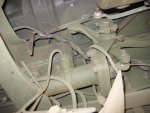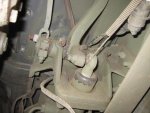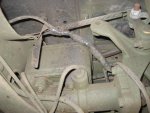First, AM G had nothing to do with designing the deuces, or even the M35A2's. The Bendix braking system was designed, and specified for the deuces long before AM G came on the scene.I have read this thread with great interest, as I would like to have the additional safety of a dual circuit system, but as no one has brought this up yet, I guess I will.
A lot of different ideas have been proposed in the last 8 pages....... but why do you think the manufacturer (AM General) or the military (they do have a hand in this sort of thing-they could simply tell the people bidding on a contract "we want it THIS way") went the way they did?
All the proposals here were at their disposal as well....... so why do you think they went the way they did? If they could have done it this easily with off the shelf parts, they could lower the price of the bid and have better chances of winning it or keep the price the same and make more profit.
But for some reason, they chose to do it the way they did.
I'd really like someone to talk to a brake systems engineer @ AM G and ask them "Why this way, with the dual airpacks and such?". I'll bet he tells us something that we have not considered.
I'm not trying to flame you guys and I can see a lot of you have put a lot of time and research into this and I am sure everyone (myself included) appreciates it.
Single circuit brakes were the standard in the automotive world when the deuces were designed. Compared to the mechanical lever brakes that preceded them, they are a marvel of safety and design excellence.
The truck designers looked at things like putting cord in the double walled brake hoses, and using tern plating inside and outside of the tempered steel brake lines, and using a double flare joint, and using all plated steel fittings, and using rivets to hold the brake linings on the brake shoes, and using solid molded rubber cup pistons backed with tight tolerance aluminum cup plungers as being the necessary overbuilding to make the system very safe.
There are a lot of single point failures in an automobile, a single circuit brake system isn't really one of them. It takes multiple failures to make the system fail. Things like the plating on the tubing needs to rust through unnoticed, and the tempered steel tube needs to rust through to make a failure. Or, the rubber hose needs to lose its outer covering, the dacron outer reinforcement, the middle rubber lining, or the inner dacron reinforcement and the inner rubber lining to fail....
Also, considering the speeds and gearing the trucks were expected to use, most of the time, brakes aren't all that essential. Put your truck in low range, and let me know what happens when you take your foot off of the pedal after running full throttle. It lumbers down to a crawl PDQ.
I have used my farm tractor for 20 years with ineffective brakes, and never missed them. I turn the throttle down, and the tractor slows to a crawl.
Please don't take anything I have said to mean that I am advocating running without fully functioning service brakes! I am advocating paying close attention to the brakes you have. If you find any rust on a line, replace it. If some joint is seeping, find out why, and fix it. If the rubber hoses are cracked, replace them. If a wheel cylinder leaks, or your fluid level drops in the MC, find out why and fix it! CHECK YOUR BRAKES! It says so right on the label on the dash of your truck! Follow that rule, and your likelihood of having a brake failure with the deuce's single circuit brake system is insignificant. It already has a great deal of redundancy built in, you just may be unaware of it.
-Chuck
Last edited:




